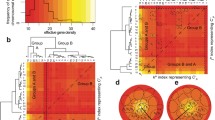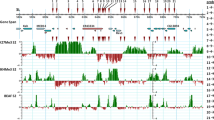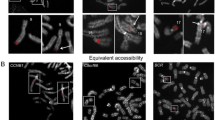Abstract
The large-scale structure of chromatin corresponding to G- and R-bands in human G0/G1 interphase nuclei was compared. Fluorescence in situ hybridization (FISH) was used to measure the interphase distance between 42 pairs of probes separated by 0.1–1.5Mbp. The probe pairs were derived from 21q22.2 and Xp21.3, G-band positive regions, and from 4p16.3, 6p21.3, and Xq28, R-band positive regions. Distributions of measured interphase distances in all regions approximated a Rayleigh distribution, suggesting that the chromatin follows a random-walk path over this range. A linear correlation of mean-square interphase distance and genomic separation, also indicative of random-walk folding, was observed in all regions. The slope of the correlation observed using probes from G-band regions was systematically lower than that from R-band regions. The difference in the slope between Xp21.3 and Xq28 was particularly striking and was observed in normal fibroblast cells, fixed alternatively with methanol and acetic acid or paraformaldehyde, and HeLa cells. These results demonstrate regional differences in large-scale chromosome structure during interphase, with the more openly configured chromatin corresponding to R-bands.
Similar content being viewed by others
References
Bernardi G (1989) The isochore organization of the human genome. Annu Rev Genet 23: 637–661.
Blanck G, Strominger JL (1988) Molecular organization of the DO subregion (DO-DX-DV-DQ) of the human MHC and its evolutionary implications. J Immunol 141: 1734–1737.
Bucan M, Zimmer M, Whaley WL et al. (1990) Physical maps of 4p16.3, the area expected to contain the Huntington disease mutation. Genomics 6: 1–15.
Cantor CR, Schimmel PR (1980) Biophysical Chemistry. New York: Freeman, pp 979–1039.
Comings DE (1968) The rationale for an ordered arrangement of chromatin in the interphase nucleus. Am J Hum Genet 20: 550–560.
Comings DE (1978) Mechanisms of chromosome banding and implications for chromosome structure. Annu Rev Genet 12: 25–46.
Craig JM, Bickmore WA (1993) Chromosome bands-flavours to savour. BioEssays 15: 349–354.
Cremer T, Kurz A, Zirbel R et al. (1993) Role of chromosome territories in the functional compartmentalization of the cell nucleus. Cold Spring Harbor Symp Quant Biol 58: 777–792.
Drouin R, Lemieux N, Richer CL (1991) Chromosome condensation from prophase to late metaphase: relationship to chromosome bands and their replication time. Cytogenet Cell Genet 57: 91–99.
DuPraw EJ (1965) Macromolecular oranization of nuclei and chromosomes: a folded fibre model based on whole-mount electron microscopy. Nature 206: 338–343.
Gardiner K (1995) Human genome organization. Curr Opin Genet Dev 5: 315–322.
Gerace L, Burke B (1988) Functional organization of the nuclear envelope. Annu Rev Cell Biol 4: 335–374.
Hahnfelt P, Hearst JE, Brenner DJ, Sachs RK, Hlatky LR (1993) Polymer models for interphase chromosomes. Proc Natl Acad Sci USA 90: 7854–7858.
Holberg M, Johnasson (1973) Preferential location of X-ray induced chromosome breakage in the R-bands of human chromosomes. Hereditas 74: 57–68.
Holmquist GP (1992) Chromosome bands, their chromatin flavors, and their functional features. Am J Hum Genet 51: 17–37.
Kenwrick S, Gitschier J (1989) A contiguous, 3-Mb physical map of Xq28 extending from the color-blindness locus to DXS15. Am J Hum Genet 45: 873–882.
Kerem B-S, Goitein R, Diamond G, Cedar H, Marcus M. (1984) Mapping of DNase I sensitive regions on mitotic chromosomes. Cell 38: 493–499.
Manuelidis L, Chen TL (1990) A unified model of eukaryotic chromosomes. Cytometry 11: 8–25.
Osoegawa K, Susukida R, Okano S et al. (1996) An integrated map with cosmid/PAC contigs of a 4-Mb Down Syndrome critical region. Genomics 32: 375–387.
Ostashevsky JY, Lange CS (1994) The 30-nm chromatin fiber as a flexible polymer. J Biomol Struct Dyn 11: 813–820.
Popp S, Scholl HP, Loos P et al. (1990) Distribution of chromosome 18 and X centric heterochromatin in the interphase nucleus of cultured human cells. Exp Cell Res 189: 1–12.
Saccone S, De Sario A, Della Valle G, Bernardi G (1992) The highest gene concentrations in the human genome are in telomeric bands of metaphase chromosomes. Proc Natl Acad Sci USA 89: 4913–4917.
Saccone S, De Sario A, Wiegant J, Raap AK, Della Valle G, Bernardi G. (1993) Correlations between isochores and chromosomal bands in the human genome. Proc Natl Acad Sci USA 90: 11929–11933.
Saccone S, Caccio S, Kusuda J, Andreozzi L, Bernardi G (1996) Identification of the gene-richest bands in human chromosomes. Gene 174: 85–94.
Sachs RK, van den Engh G, Trask B, Yokota H, Hearst JE (1995) A random-walk/giant-loop model for interphase chromosomes. Proc Natl Acad Sci USA 92: 2710–2714.
Saitoh Y, Laemmli UK (1994) Metaphase chromosome structure: bands arise from a differential folding path of the highly AT-rich scaffold. Cell 76: 609–622.
Sambrook J, Fritsch EF, Maniatis T (1989) Molecular Cloning, A Laboratory Manual, 2nd edn. Cold Spring Harbor, NY: Cold Spring Harbor Laboratory Press.
Schultz J (1947) The nature of heterochromatin. Cold Spring Harbor Symp Quant Biol 12: 179–181.
Spies T, Blanck G, Bresnahan M, Sands J, Strominger JL (1989) A new cluster of genes within the human major histocompatibility complex. Science 243: 214–217.
Trask B (1997) Fluorescence in situ hybridization. In: Birren B, Green E, Hieter P, Myers R eds. Genome Analysis: a Laboratory Manual. Cold Spring Harbor, NY: Cold Spring Harbor Laboratory Press (in press).
Trask BJ, Pinkel D, van den Engh GJ (1989) The proximity of DNA sequences in interphase cell nuclei is correlated to genomic distance and permits ordering of cosmids spanning 250 kilobase pairs. Genomics 5: 710–717.
Trask BJ, Massa H, Kenwrick S, Gitschier J (1991) Mapping of human chromosome Xq28 by 2-color fluorescence in situ hybridization of DNA sequences to interphase cell nuclei. Am J Hum Genet 48: 1–15.
Trask BJ, Allen S, Massa H et al. (1993) Studies of metaphase and interphase chromosomes using fluorescence in situ hybridization. Cold Spring Harbor Symp Quant Biol 58: 767–775.
van den Engh GJ, Sachs R, Trask BJ (1992) Estimating genomic distance from DNA sequence location in cell nuclei by a random walk model. Science 257: 1410–1412.
Walker AP, Chelly J, Love DR et al. (1992) AYAC contig in Xp21 containing the adrenal hyposia congenita and glycerol kinase deficiency genes. Hum Mol Genet 1: 579–585.
Weintraub H, Grodine M (1976) Chromosomal subunits in active genes have an altered conformation. Science 193: 848–856.
Weisbrod S (1982) Active chromatin. Nature 297: 289–295.
Whaley W, Bates G, Novelletto A et al. (1991) Mapping of cosmid clones in Huntington's disease region of chromosome 4. Somatic Cell Mol Genet 17: 83–91.
Yokota H, van den Engh G, Hearst JE, Sachs RK, Trask BJ (1995) Evidence for the organization of chromatin in megabase pair-sized loops arranged along a random walk path in the human G0/G1 interphase nucleus. J Cell Biol 130: 1239–1249.
Author information
Authors and Affiliations
Rights and permissions
About this article
Cite this article
Yokota, H., Singer, M.J., van den Engh, G.J. et al. Regional differences in the compaction of chromatin in human G0/G1 interphase nuclei. Chromosome Res 5, 157–166 (1997). https://doi.org/10.1023/A:1018438729203
Issue Date:
DOI: https://doi.org/10.1023/A:1018438729203




